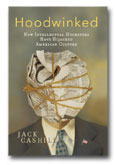Abortion, Eugenics and Ruth Bader Ginsberg
Get your copy of Deconstructing Obama

___
Jack Cashill's book:
Hoodwinked: How Intellectual Hucksters have Hijacked American Culture

Click here for signed first edition
©Jack Cashill
WND.com - December 26, 2012
 In a recent article in Slate Emily Bazelon attempts to purge from the record comments Justice Ruth Bader Ginsburg (left) made to Bazelon about abortion a few years prior.
In a recent article in Slate Emily Bazelon attempts to purge from the record comments Justice Ruth Bader Ginsburg (left) made to Bazelon about abortion a few years prior.
In a 2009 interview for the New York Times Magazine, Ginsburg said the following, “Frankly I had thought that at the time Roe was decided, there was concern about population growth and particularly growth in populations that we don’t want to have too many of.”
In the course of the Slate article, Bazelon goes to great and unconvincing lengths to explain why Ginsburg did not mean “too many of” quite the way it sounds like she meant it.
Her efforts here should not surprise. The feminist establishment has a century of experience cleaning up the rhetorical messes made by its spokespeople in their more honest moments.
 No one made more of a mess than the woman who introduced the very phrase “birth control,” Planned Parenthood founder, Margaret Sanger (right). In describing the tradition that Sanger pioneered, Bazelon shows her willingness to turn a blind eye to the Sanger legacy as well.
No one made more of a mess than the woman who introduced the very phrase “birth control,” Planned Parenthood founder, Margaret Sanger (right). In describing the tradition that Sanger pioneered, Bazelon shows her willingness to turn a blind eye to the Sanger legacy as well.
“The history lesson is this,” writes Bazelon, “There was a feminist women’s rights argument for legal abortion in the 1970s, which the Supreme Court accepted in Roe v. Wade. And there was a separate and distinct argument about preventing population growth by being pro-abortion . . . “
No, Emily, women’s rights and population control were not conceived separately. They were born conjoined in Sanger’s fevered imagination. In her essential 1922 book, the “Pivot of Civilization,” Sanger made this linkage explicit.
As Sanger saw it, there were two primary reasons why birth control was necessary. The first, the one that has endured in progressive mythology, is “the liberation of the spirit of woman and through woman of the child.”
The second, the one that has been cleansed from the record, is “to prevent the sexual and racial chaos into which the world has drifted.”
In Sanger’s view, those two urges complemented each other. “The potential mother,” she wrote, “can then be shown that maternity need not be slavery but may be the most effective avenue to self-development and self-realization. Upon this basis only may we improve the quality of the race.”
A product of her age, Sanger had absorbed the Darwinian ethos and made it her own. “We must temper our emotion and enthusiasm with the impersonal determination of science,” she argued, and she used the available science at every opportunity to reinforce her thesis.
In the following, Sanger showed a flash of the pseudo-sci-fi scare language that other leftist scam artists from Rachel Carson to Al Gore would raise to an art form:
“There is every indication that feeble-mindedness in its protean forms is on the increase, that it has leaped the barriers, and that there is truly, as some of the scientific eugenists (sic) have pointed out, a feeble-minded peril to future generations—unless the feeble-minded are prevented from reproducing their kind.”
Sanger cited one study that claimed 47.3 percent of all American draftees were, in her less than charitable words, “morons.”
In reviewing the remedies for dealing with a half-moron nation, she showed nothing but scorn for “organized charity,” which, she wrote, “itself is the symptom of a malignant social disease.”
By keeping so many “defectives, delinquents, and dependents” alive and breeding, charity seemed to Sanger a “positive injury to the future of the race.”
Salvation Army bell ringers got nothing from Sanger but the evil eye. She wrote off their efforts as a “debauch of sentimentalism” and argued that they did more harm than good.
In Sanger’s heyday, as history notes, Nazi Germany had its own eugenics plan, but Sanger thought that plan lethally weak in the knees.
Through education and persuasion, the Nazis hoped to inspire “fit” women to outbreed the “unfit,” but according to Sanger, such “cradle competition” did nothing to thwart that “ever-increasing army of under-sized, stunted, and dehumanized slaves.”
Any plan to outbreed these people, Sanger believed, would inevitably fail the race and deny fit women mastery over their own bodies. Society could not leave to “chance and chaotic breeding” the perpetuation of the unfit.
Of course, when the fall of Nazi Germany revealed the down side of the eugenics movement, Sanger and her allies began to see that they had a public relations problem.
Still, the cultural establishment dared not turn its back on the already iconic Sanger. She had proved herself essential to the flowering of the sexual revolution, and no organization would prove more critical to its nurturing than Planned Parenthood.
To this day, the organization does not disguise Sanger’s importance. “Margaret Sanger gained worldwide renown, respect, and admiration for founding the American birth control movement and, later, the Planned Parenthood Federation of America,” reads the proud tribute to Sanger on the Planned Parenthood Web site.
What Planned Parenthood has disguised—with the help of the cultural establishment—is the very core of Sanger’s philosophy. True, the organization does admit that some of the “popular ideas” she adopted are “out of keeping with our thinking today.” Out of keeping? You think?
But from Planned Parenthood’s perspective, Sanger’s “visionary accomplishments” so overwhelm those “outmoded” ideas that the latter are scarcely worth talking about.
Similarly, from Bazelon’s perspective, “to imagine that Justice Ginsburg would endorse eugenics as a motivation for supporting legal abortion, you have to be out to get her.”
Why does Bazelon believe that? “I say that,” she adds, “because this notion is so entirely at odds with her life’s work advocating for equal rights for women, especially poor women.”
Sanger advocated for equal rights too, and that advocacy covered for a lot of sins. In 1966, every one of them was ignored in the New York Times glowing 2200-word obituary for this “dynamic, titian-haired woman whose Irish ancestry also endowed her with unfailing charm and persuasive wit.”
But then again, the Times has always been good at cleaning up messes.
Webmaster's Note: Jack Cashill's Book-TV presentation of "Deconstructing Obama" can be viewed at http://www.c-spanvideo.org/program/298382-1
Editor's note: For a more complete account of this phenomenon, read Jack Cashill's amazing book, "Hoodwinked: How Intellectual Hucksters Have Hijacked American Culture.

